
 Image: IDG / Matthew Smith
Image: IDG / Matthew Smith
At a glance
Expert’s Rating
Pros
Attractive design with compact standEasy-to-navigate menus with remote controlExcellent video connectivityGood all-around SDR and HDR image quality
Cons
Expensive for a 1440p, 240Hz OLED monitorUSB-C power supports limited Power DeliveryQD-OLED peers beat it in SDRHDR image quality has some rough edges
Our Verdict
The ViewSonic XG272-2K-OLED benefits from practical design and tons of ports, but it can’t beat less expensive OLED monitors on image quality.
Price When Reviewed
$899.99
Best Prices Today: ViewSonic XG272-2K-OLED
RetailerPriceViewSonic$899.99View Deal
2024 is clearly the year of gorgeous OLED gaming monitors, but this sudden explosion in options leaves gamers facing many choices with nearly identical specifications. ViewSonic’s XG272-2K-OLED stands apart from the alternatives with a semi-gloss LG WOLED panel and gobs of connectivity, though these features unfortunately bump up the price.
Further reading: Best gaming monitors 2024: Level up your display
ViewSonic XG272-2K-OLED: Specs & features
The ViewSonic XG272-2K-OLED is yet another 27-inch OLED monitor with 2560×1440 resolution. This is essentially the industry standard among 27-inch OLED monitors (for now, at least). However, the XG272-2K-OLED is part of a new wave of monitors with an LG WOLED panel instead of Samsung’s QD-OLED.
Display size: 27-inch widescreenNative resolution: 2560×1440Panel type: Glossy WOLEDRefresh rate: Up to 240HzAdaptive Sync: Adaptive Sync 240, AMD FreeSync Premium Pro, Nvidia G-SyncHDR: Yes, HDR10Ports: 2x HDMI 2.1, 2x DisplayPort 1.4, 1x USB-C (upstream), 1x USB-B (upstream), 3x USB-A (downstream), 1x 3.5mm audio-outVESA mount: 100mm x 100mmSpeakers: Yes, 2x 3-watt stereo speakersPrice: $899.99 MSRP
It also differs from competitors on connectivity. Most monitors in this category have three or four video inputs and skip USB-C, but the ViewSonic includes two HDMI 2.1, two DisplayPort, and USB-C, plus three USB-A downstream ports. That’s far better than average, though it’s reflected in the monitor’s $899.99 MSRP.
ViewSonic XG272-2K-OLED: Design
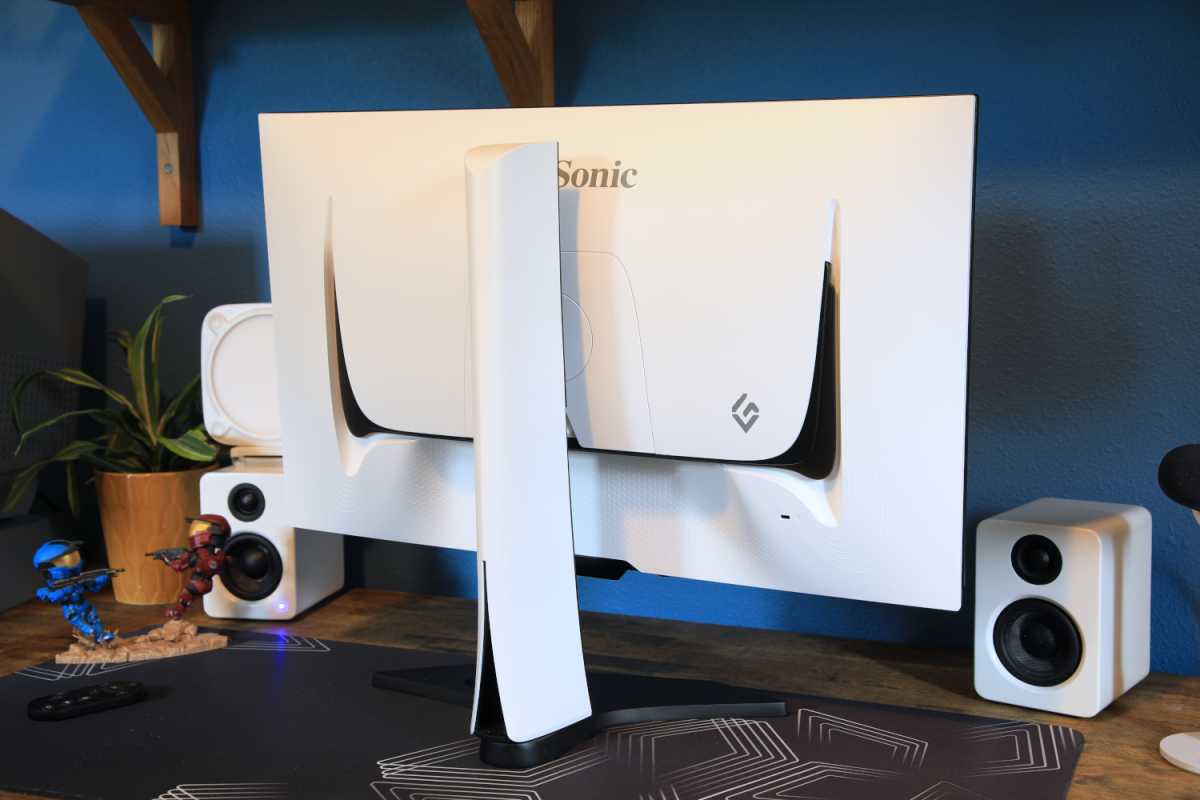
IDG / Matthew Smith
IDG / Matthew Smith
IDG / Matthew Smith
The ViewSonic XG272-2K-OLED is available only in an attractive sheer white colorway that seems to split the difference between gaming and professional monitor design. It pairs a customizable RGB light and swooping vents with a conventional panel shape and small, unobtrusive stand. The result isn’t as cohesive as design leaders like the Alienware AW2725DF or Samsung’s new Odyssey OLED G8, but it’s eye-catching.
As mentioned, the XG272 is graced with a compact stand that minimizes the monitor’s footprint on your desk. It’s flat, too, so the desk space it occupies remains usable. The stand has a small cut-out for the monitor’s remote control (more on that in a bit) and provides significant ergonomic adjustment including height, tilt, swivel, and pivot. The monitor also has a 100mm x 100mm VESA mount for attaching a third-party monitor stand or arm.
ViewSonic XG272-2K-OLED: Connectivity and menus
ViewSonic doesn’t skimp on the XG272-2K-OLED’s connectivity. On the contrary, it might be the best reason to buy the monitor.
It has two HDMI 2.1 ports, two DisplayPort 1.4 ports, and one USB-C port with DisplayPort Alternate Mode and 15 watts of Power Delivery. That’s a total of five video inputs, all of which support the monitor’s maximum resolution and refresh rate.
The monitor also has three downstream USB-A ports, which is excellent. Most competitors have two USB-A ports or, in some cases, none at all. The USB-A ports can be accessed over the USB-C port, which makes the XG272 a useful USB hub for a laptop, or over a USB-B connection, which is useful for connecting a desktop PC. The USB-C ports limited Power Delivery is a downside, though, as it’s not enough to reliably charge even the most miserly laptops.
ViewSonic’s on-screen menu system is logically arranged and well-labeled, though the font is a bit small. It can be accessed with a joystick centered on the lower bezel or the bundled remote control. The remote is an excellent feature for people who plan to change settings quickly, and the stand even includes a nook for the remote. However, the remote felt cheap and didn’t respond quickly to input. The remotes paired with some BenQ Mobiuz and Samsung M8 monitors are more responsive.
The on-screen menu offers significant image quality customization, but I wasn’t happy with some of ViewSonic’s decisions. Color temperature customization is included, but the color temperature settings have vague labels instead of numerical values (the manual clarifies this, but the overall range of preset color temperature adjustment is less than ideal). Gamma adjustment wasn’t available, and the monitor also lacks DCI-P3 and AdobeRGB presets. Six-axis color saturation adjustment is available, however.
Gamers will find a lot to dig into. The monitor has a black stabilizer feature (which increases the brightness of dark areas of the display to make foes easier to see). It also has a crosshair and several custom aspect ratio modes including a 24-inch 16:9 mode and 19-inch 4:3 mode. There’s also several VRR and BFI settings, which I’ll discuss in the motion clarity section of this review.
A pair of three-watt speakers are included, but they’re not great. The speakers are better understood as a back-up for situations where other speakers are unavailable than a sound system you’d want to use day-to-day.

IDG / Matthew Smith
IDG / Matthew Smith
IDG / Matthew Smith
ViewSonic XG272-2K-OLED: SDR image quality
The ViewSonic XG272-2K-OLED has an LG WOLED panel similar to the Asus ROG Strix XG27AQDMG though, unlike the Asus, ViewSonic opts for an anti-glare finish. The XG272’s overall performance is similar to the ROG Strix XG27AQDMG and tends to slightly lag QD-OLED monitors in SDR content, though the difference is often so slim that most gamers wouldn’t notice it.
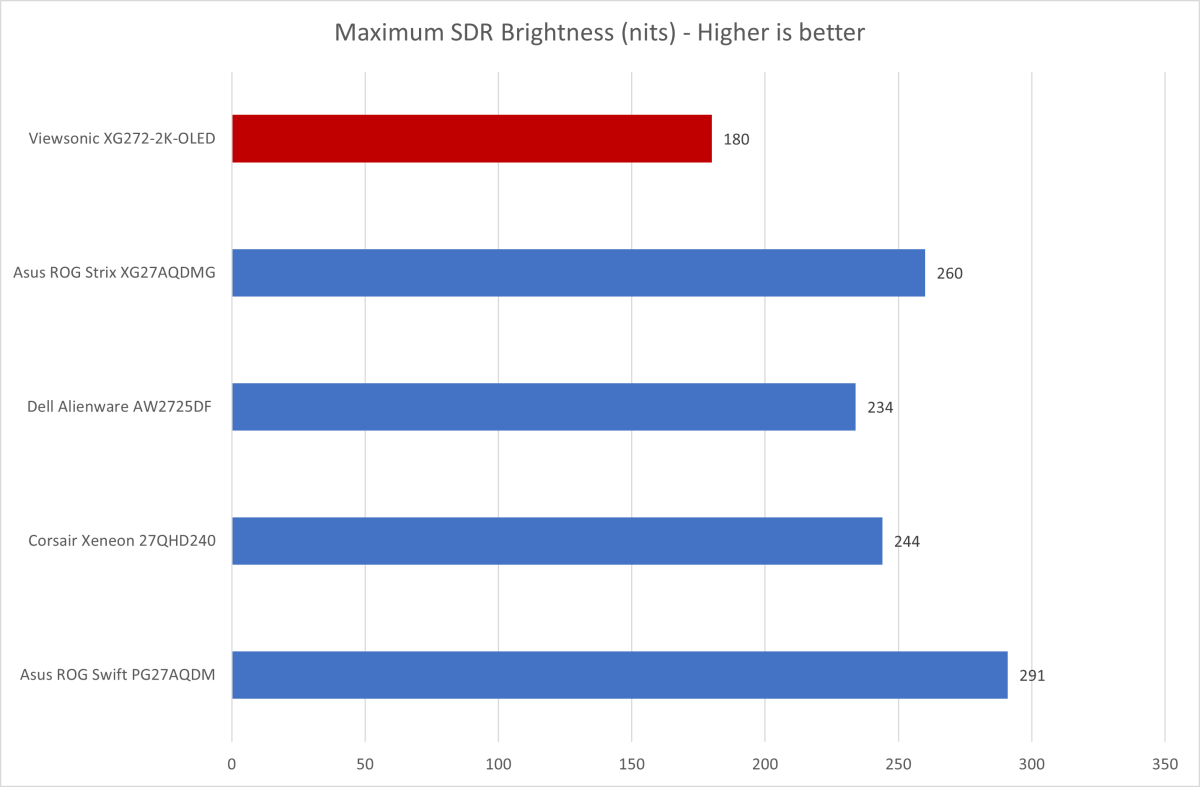
IDG / Matthew Smith
IDG / Matthew Smith
IDG / Matthew Smith
First up is brightness, and here the ViewSonic XG272-2K-OLED reached a disappointing peak brightness of 180 nits in SDR. That’s low even among OLED monitors, which tend towards a much lower peak brightness in SDR than most monitors.
ViewSonic advertises up to 250 nits, and I was able to get close to that figure in some of the monitor’s image quality presets, such as the Vibrant mode. However, the presets that offer a higher level of brightness aren’t very attractive, and I wasn’t able to reach over 200 nits in the standard image mode even with the monitor’s energy saving features turned off.
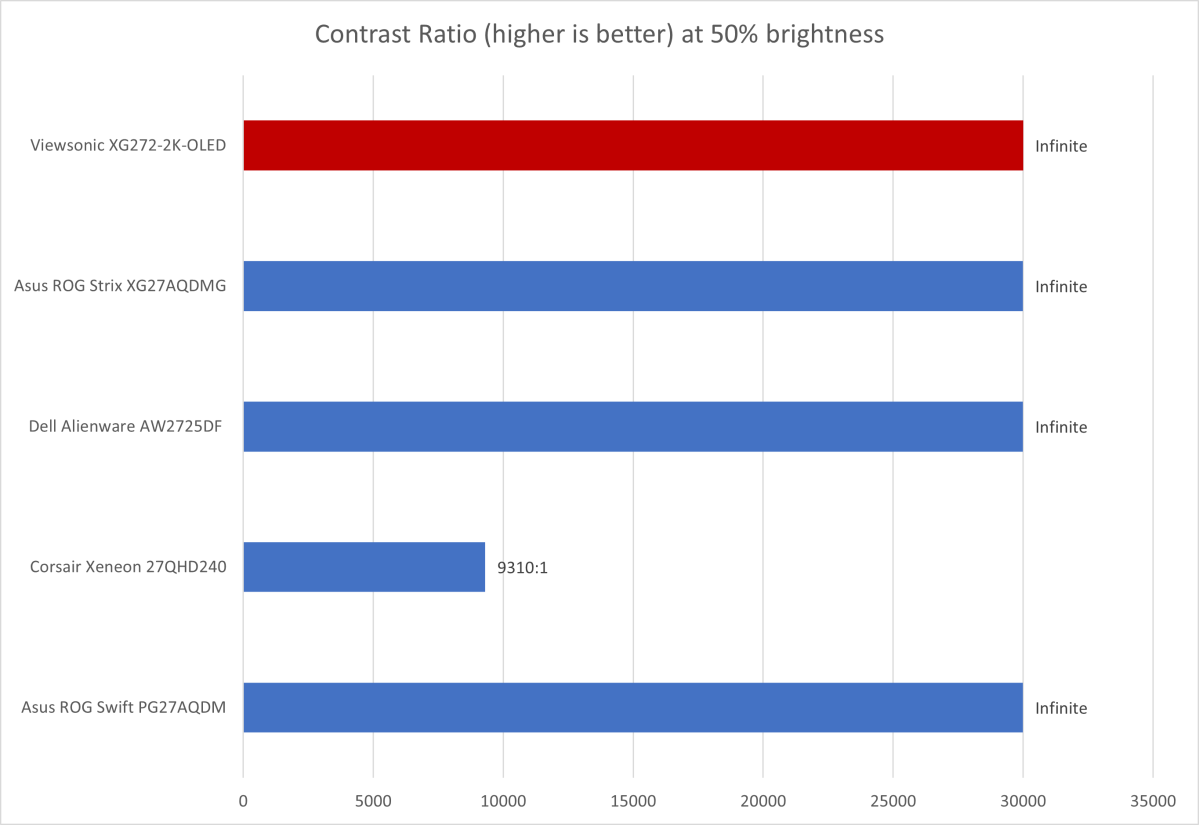
IDG / Matthew Smith
IDG / Matthew Smith
IDG / Matthew Smith
Contrast is a traditional strength of OLED, as the technology can achieve a “perfect” black level of zero nits. Put differently, an OLED panel can reduce the brightness of each individual pixel to zero, and do so independently of any adjacent pixel. The result is a realistic, immersive look that’s well-suited to games, movies, photographs, and content creation.
But this perk is shared by all modern OLED monitors. I haven’t tested all the OLED monitors available right now, but I’ve tried quite a few, and all monitor’s I’ve tried with panels from the most recent generations of Samsung QD-OLED and LG WOLED technology have excellent contrast.
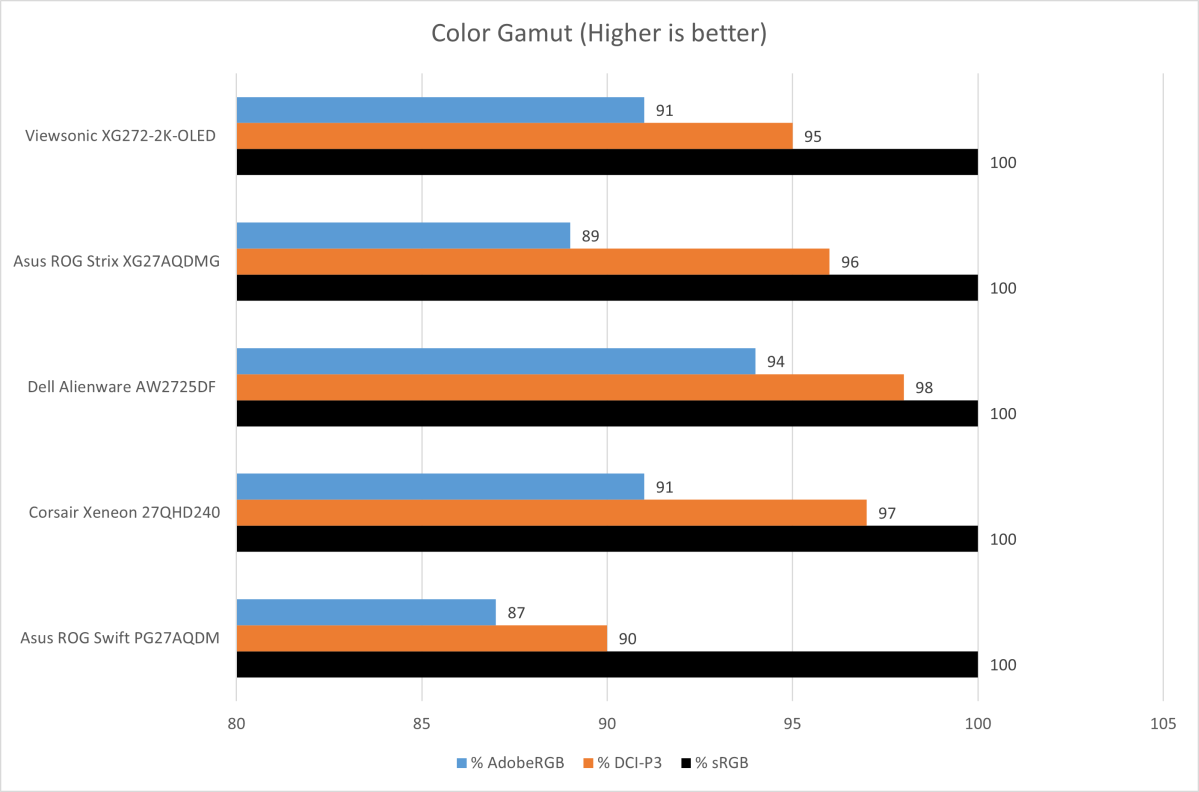
IDG / Matthew Smith
IDG / Matthew Smith
IDG / Matthew Smith
The XG272’s color gamut spanned 100 percent of sRGB, 95 percent of the DCI-P3 and 91 percent of AdobeRGB. These are excellent results and on par with the Asus ROG Strix XG27AQDMG, but behind QD-OLED monitors like the Alienware AW2725DF.
In practice, I don’t think the XG272’s color gamut will be an obstacle for gamers, but content creators should keep it in mind. The XG272’s gamut is good, but QD-OLED monitors with better performance are available at the same price.

IDG / Matthew Smith
IDG / Matthew Smith
IDG / Matthew Smith
Color accuracy is another sore spot, as the XG272 comes in behind QD-OLED monitors. Its performance is more similar to the Asus ROG Strix XG27AQDMG, which also has a WOLED panel.
As with color gamut, the XG272’s color accuracy is still sufficient to provide an attractive, alluring image. I doubt most people, myself included, would ever notice an issue without close study of test images and calibration results. Still, the XG272 is not the best option if out-of-box color accuracy is important to you.
The XG272’s color issues are reinforced by its color temperature and gamma results. The monitor’s default color temperature came in at 6900K, which is cooler than the preferred target of 6500K. I also measured a gamma curve of 2.1, below the target of 2.2, which means content will look slightly brighter and more luminous than it should (though the difference is too small to notice in many situations). ViewSonic provides options to calibrate color temperature and gamma but, as mentioned earlier, the specifics of the monitor’s controls make it a bit difficult to tune these aspects of image quality. Calibration software may be required to dial in the image.
Sharpness is an issue. Pixelation and color fringing was noticeable when reading small fonts and along some high-contrast borders in productivity software (it’s especially noticeable in Microsoft Excel). All current 27-inch 1440p OLED monitors share this problem, which is caused by the unusual subpixel layout used by Samsung QD-OLED and LG WOLED panels. Monitors with a higher resolution, like the 32-inch 4K Alienware AW3225QF, tend to side-step this problem, but it remains an issue at 1440p. With that said, I felt the XG272 was ever-so-slightly better than the ROG Strix XG27AQDMG.
On balance, the ViewSonic XG272-2K-OLED’s SDR image quality is excellent but behind the best QD-OLED monitors, such as the Alienware AW2725DF. The reality is that any of the OLED monitors listed in the graphs above will deliver a jaw-dropping improvement if you’re upgrading from an older IPS-LCD or VA-LCD panel. Still, the benchmarks matter, and the XG272 suffers several minor defeats when compared to its peers.
ViewSonic XG272-2K-OLED: HDR image quality
The ViewSonic XG272-2K-OLED delivered remarkable brightness in HDR tests. It achieved a maximum brightness of 1064 nits in a 10 percent window, meaning 10 percent of the display was lit (the rest displayed a uniform black image at zero nits). It also hit 541 nits in a 50 percent window and sustained 249 nits when the entire display was lit.
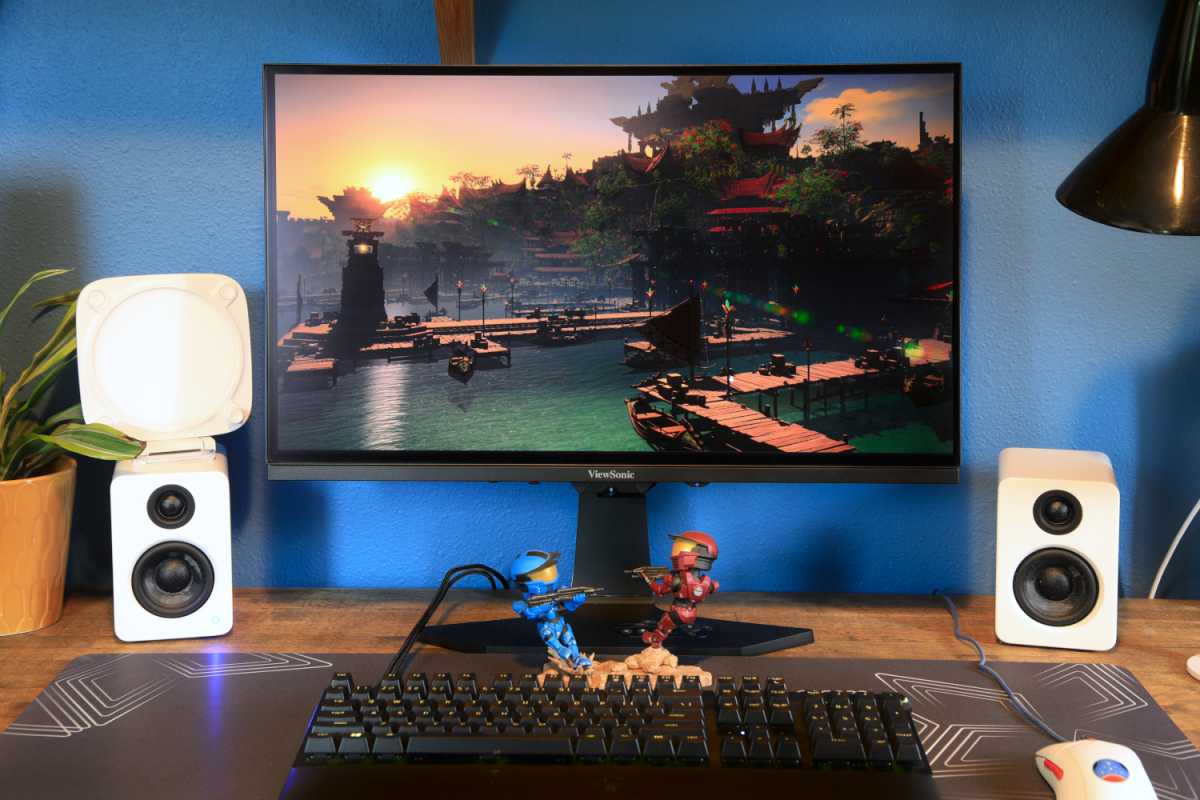
IDG / Matthew Smith
IDG / Matthew Smith
IDG / Matthew Smith
These are excellent results. The XG272’s peak brightness in a 10 percent window beats the Asus ROG Strix XG27AQDMG, which hit 724 nits, and obliterates the Alienware AW2725DF. In fact, the XG272 sets a new record for OLED monitor brightness in a 10 percent window. However, the Asus monitor was brighter when 50 percent of 100 percent of the display was lit.
While these figures are excellent, I was less impressed by the XG272’s real-world performance. The test clips I use for evaluating this, which includes the “Gargantua” scene from Interstellar and the “Into the Storm” scene from Mad Max: Fury Road, showed less detail in bright areas of the scene than with the Asus ROG Strix XG27AQDMG.
I also noticed the XG272 struggled with SDR apps when HDR was turned on. The image was desaturated and gamma scaling was all over the map, which caused SDR apps to appear too dark. The XG272 didn’t detect when I flipped HDR on or off in the Windows 11 settings, either, so I had to select the monitor’s HDR mode.
The XG272’s HDR performance is a bit of a mix as a result. Though it can reach an excellent level of HDR brightness, the monitor’s HDR implementation is rough around the edges, and the Asus ROG Strix XG27AQDMG remains a better choice for HDR content.
ViewSonic XG272-2K-OLED: Motion performance
Gamers will enjoy the ViewSonic XG272-2K-OLED’s maximum refresh rate of 240Hz and lightning-quick gray-to-gray pixel response times of just 0.02 milliseconds. These traits provide an exceptionally clear, crisp image. Small, fast objects are easy to track. Scrolling test images from DOTA 2 and League of Legends showed that fine elements, like character names and hit point bars, are legible while scrolling across the map, though clarity still has room for improvement.
The monitor has a black frame insertion (BFI) feature that can flicker the display at high frequencies to reduce perceived motion clarity. Unfortunately, it only operates up to a maximum refresh rate of 120Hz, which makes the features less useful. I didn’t notice much difference in clarity between 120Hz with BFI on and 240Hz with BFI off, which was also true of the Asus ROG Strix XG27AQDMG. However, this feature might still be useful if you’re playing a demanding game that can achieve a frame rate above 120 frames per second.
Adaptive Sync is supported, as well, and the XG272 has official support for Nvidia G-Sync Compatible and AMD FreeSync Premium Pro. Competing monitors also tend to work with both, but some manufacturers don’t bother with certification. Official support for both standards provides some peace of mind for gamers.
ViewSonic XG272-2K-OLED: Conclusion
The ViewSonic XG272-2K-OLED is a strong WOLED monitor with several features that could make it alluring to specific gamers. It has lots of connectivity, including a USB-C port and several USB-A ports. ViewSonic also provides a compact ergonomic stand and a remote control. These features inflate the price, however, and the XG272’s overall image quality isn’t better than less expensive competitors like the Asus ROG Strix XG27AQDMG. That narrows the ViewSonic’s appeal. But if you need a lot of connectivity, or you spot the monitor on sale for a price closer to its competition, the XG272 is a solid choice.
Best Prices Today: ViewSonic XG272-2K-OLED
RetailerPriceViewSonic$899.99View Deal
Author: Matthew S. Smith
Matthew S. Smith is a freelance technology journalist with 15 years of experience reviewing consumer electronics. In addition to PCWorld, his work can be found on Wired, Ars Technica, Digital Trends, Reviewed, IGN, and Lifewire. Matthew also covers AI and the metaverse for IEEE Spectrum and runs Computer Gaming Yesterday, a YouTube channel devoted to PC gaming history.
Recent stories by Matthew S. Smith:
Best 4K monitors 2024: HDR, 144Hz, budget, and best overallBest gaming monitors 2024: Level up your displayBest home office monitors 2024: Displays that get the job done


